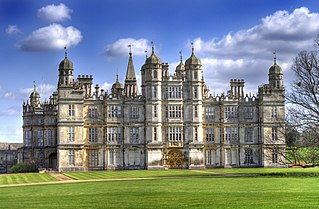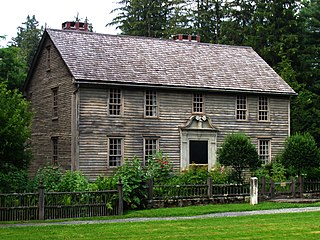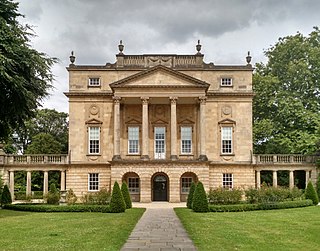
The National Gallery is an art museum in Trafalgar Square in the City of Westminster, in Central London, England. Founded in 1824, in Trafalgar Square since 1838, it houses a collection of over 2,300 paintings dating from the mid-13th century to 1900. The current Director of the National Gallery is Gabriele Finaldi.

Winterthur Museum, Garden and Library is an American estate and museum in Winterthur, Delaware. Winterthur houses one of the richest collections of Americana in the United States. The museum and estate were the home of Henry Francis du Pont (1880–1969), Winterthur's founder and a prominent antiques collector and horticulturist.

Kingston Lacy is a country house and estate near Wimborne Minster, Dorset, England. It was for many years the family seat of the Bankes family who lived nearby at Corfe Castle until its destruction in the English Civil War after its incumbent owners, John Bankes and Dame Mary, had remained loyal to Charles I.

Waddesdon Manor is a country house in the village of Waddesdon, in Buckinghamshire, England. Owned by the National Trust and managed by the Rothschild Foundation, it is one of the National Trust's most visited properties, with over 463,000 visitors in 2019.

Preston Hall is an early 19th century mansion house at Preston-on-Tees, about 4 km south of the centre of Stockton-on-Tees, England. It has been a museum since 1953 and is owned by Stockton-on-Tees Borough Council. It is a listed building. The house stands in 100 acres (0.40 km2) of parkland. The grounds of the house form Preston Park.

Chiddingstone is a village and civil parish in the Sevenoaks District of Kent, England. The parish is located on the River Eden between Tonbridge and Edenbridge. The villages of Chiddingstone Causeway and Bough Beech and the hamlet Chiddingstone Hoath are also included in the parish.

Iford Manor is a manor house in Wiltshire, England. It is a Grade II* listed building sitting on the steep, south-facing slope of the Frome valley, in Westwood parish, about 2 miles (3.2 km) southwest of the town of Bradford-on-Avon. Its Grade I registered gardens are open to the public from April to September each year.

Burghley House is a grand sixteenth-century English country house near Stamford, Lincolnshire. It is a leading example of the Elizabethan prodigy house, built and still lived in by the Cecil family and is Grade I listed.

Kenwood House is a former stately home in Hampstead, London, on the northern boundary of Hampstead Heath. The house was originally constructed in the 17th century and served as a residence for the Earls of Mansfield during the 18th and 19th centuries.

Blaise Castle is a folly built in 1766 near Henbury in Bristol, England. The castle sits within the Blaise Castle Estate, which also includes Blaise Castle House, a Grade II* listed 18th-century mansion house. The folly castle is also Grade II* listed and ancillary buildings including the orangery and dairy also have listings. Along with Blaise Hamlet, a group of nine small cottages around a green built in 1811 for retired employees, and various subsidiary buildings, the parkland is listed Grade II* on the Register of Historic Parks and Gardens of special historic interest in England.

Elvaston Castle is a stately home in Elvaston, Derbyshire, England. The Gothic Revival castle and surrounding parkland is run and owned by Derbyshire County Council as a country park known as Elvaston Castle Country Park. The country park has 200 acres (0.81 km2) of woodlands, parkland and formal gardens.

Guildford Museum is the main museum in the town of Guildford, Surrey, England. The museum is on Quarry Street, a narrow road lined by pre-1900 cottages running just off the pedestrianised High Street. This main site of the museum forms the gatehouse and annex of Guildford Castle, which the staff help to run. It is run by Guildford Borough Council and has free entry between 11am and 4:45pm on Monday to Saturday. It is closed on Sundays and on Christmas Day.

The Mission House is an historic house located at 19 Main Street, Stockbridge, Massachusetts. It was built between 1741 and 1742 by a Christian missionary to the local Mahicans. It is a National Historic Landmark, designated in 1968 as a rare surviving example of a colonial mission house. It is now owned and operated as a nonprofit museum by the Trustees of Reservations.

York Castle Museum is a museum located in York, North Yorkshire, England, on the site of York Castle, which was originally built by William the Conqueror in 1068. The museum itself was founded by John L. Kirk in 1938, and is housed in prison buildings which were built on the site of the castle in the 18th century, the debtors' prison and the female prison.

The Holburne Museum is located in Sydney Pleasure Gardens, Bath, Somerset, England. The city's first public art gallery, the Grade I listed building, is home to fine and decorative arts built around the collection of Sir William Holburne. Artists in the collection include Gainsborough, Guardi, Stubbs, Ramsay and Zoffany.

Cliffe Castle Museum, Keighley, West Yorkshire, England, is a local heritage museum which opened in the grand, Victorian, neo-Gothic Cliffe Castle in 1959. Originating as Cliffe Hall in 1828, the museum is the successor to Keighley Museum which opened in Eastwood House, Keighley, in c. 1892. There is a series of galleries dedicated to various aspects of local heritage, and to displaying the house itself, which is a Grade II listed building. Entrance to the museum is free of charge.

Strawberry Hill House—often called simply Strawberry Hill—is a Gothic Revival villa that was built in Twickenham, London, by Horace Walpole (1717–1797) from 1749 onward. It is a typical example of the "Strawberry Hill Gothic" style of architecture, and it prefigured the nineteenth-century Gothic Revival.
Robert Streatfeild of Chiddingstone, Kent is the earliest known ancestor to which most known Streatfeilds and Streatfields can trace their ancestry, and the progenitor of the Streatfeild family.
Richard Streatfeild of Chiddingstone, Kent was an ironmaster who established the financial base for this significant Kentish family.

The Streatfeilds, Streatfields or Stretfields are an aristocratic English family of the landed gentry, from Chiddingstone, Kent. The family are traceable to the early 16th century and are a possible cadet branch of the Noble House of Stratford. They were significant landowners in Sussex, Surrey and Kent, and instrumental in shaping those counties throughout the 17th and 18th centuries. From the early 16th century until 1900 the family seat was Chiddingstone Castle. The family later sold the castle to Lord Astor in 1938.






















